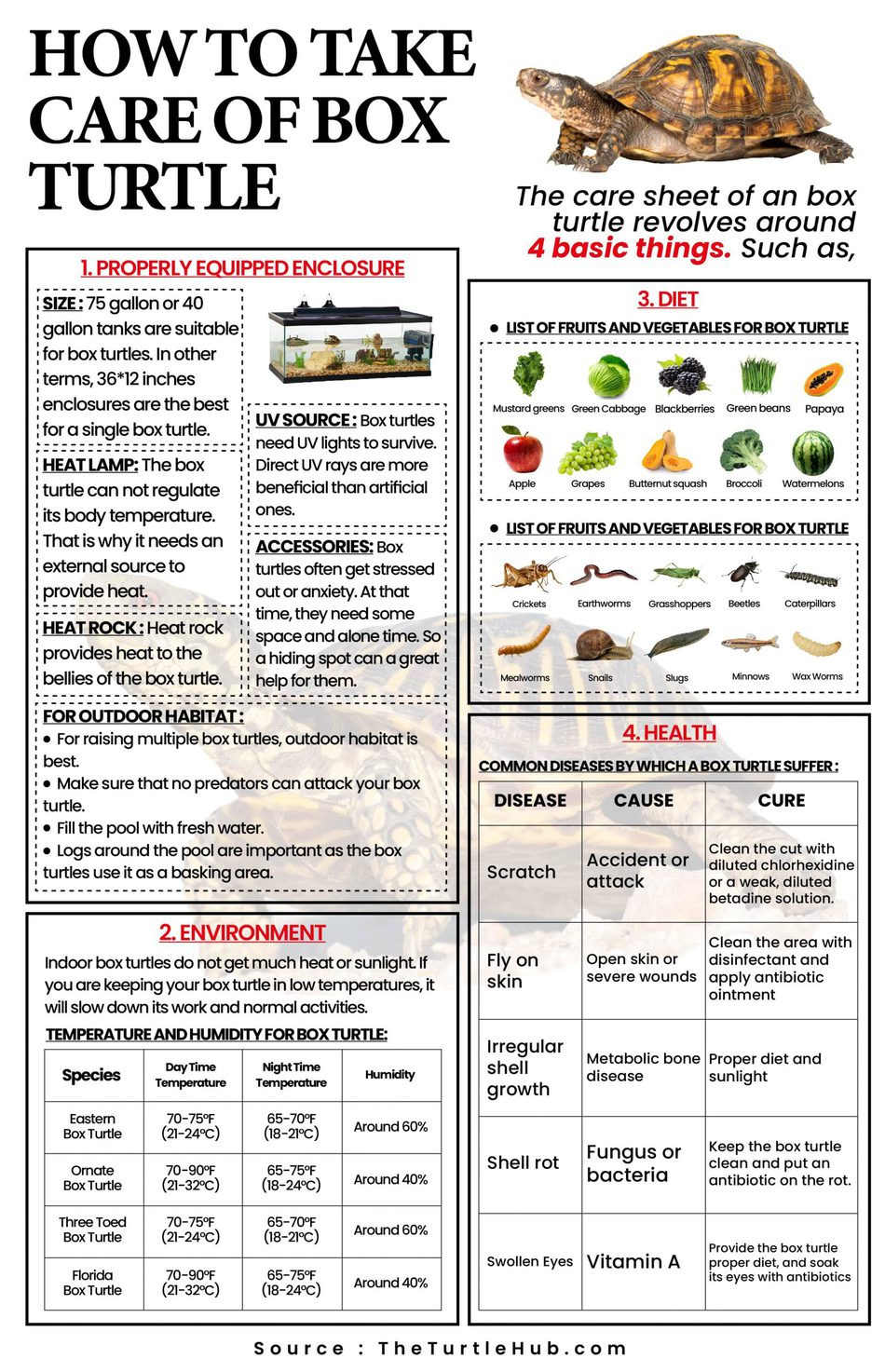Eastern Box Turtle Care: How To Keep Your Turtle Happy
Are you a proud owner of an Eastern Box Turtle? Do you want to ensure that your shelled companion is happy and healthy? Look no further! In this article, we’ll cover the basics of Eastern Box Turtle care, including diet, habitat, and enrichment activities to keep your turtle thriving. So, let’s dive in and learn how to keep your turtle happy!

Eastern Box Turtle Care: How to Keep Your Turtle Happy
Eastern box turtles are fascinating creatures that make great pets. These small, terrestrial turtles are native to the eastern United States and require specific care to thrive. Here’s what you need to know to keep your Eastern box turtle happy and healthy.
1. Habitat
The first step to keeping your Eastern box turtle happy is to provide it with the right habitat. These turtles require an enclosure that is at least four times the size of their shell length. They also need a substrate that is easy to burrow in, such as coconut coir or sphagnum moss. Provide hiding places and climbing opportunities, such as rocks or logs, to keep your turtle stimulated.
It’s important to maintain a temperature gradient in the enclosure. The basking area should be around 90 degrees Fahrenheit, while the cooler end should be around 70 degrees. Use a UVB light to provide your turtle with the necessary UV radiation to stay healthy.
2. Diet
Eastern box turtles are omnivores and require a varied diet. Offer a mix of vegetables, such as dark leafy greens and carrots, as well as protein, such as insects or cooked chicken. Avoid feeding your turtle too much fruit or sugary treats.
Supplement your turtle’s diet with calcium and vitamin D3 to prevent metabolic bone disease. Offer cuttlebone or a calcium supplement, and provide a UVB light to aid in vitamin D3 synthesis.
3. Water
Eastern box turtles require access to clean water at all times. A shallow dish of water that is changed regularly is sufficient. Some turtles may also enjoy soaking in a larger water dish or shallow pool.
4. Health
Regular veterinary check-ups are crucial to maintaining your turtle’s health. Watch for signs of illness, such as lethargy, loss of appetite, or shell rot. Keep the enclosure clean and disinfected to prevent the spread of disease.
5. Handling
Eastern box turtles can become stressed if handled too frequently. Limit handling to once or twice a week and always support the turtle’s body. Avoid picking up the turtle by its shell, as this can cause injury.
6. Exercise
Provide opportunities for your turtle to exercise by offering climbing opportunities and hiding places. You can also create an obstacle course or use a shallow pool for swimming.
7. Lifespan
Eastern box turtles can live up to 40 years in captivity with proper care. Make sure you are prepared for the long-term commitment of owning a turtle before bringing one home.
8. Benefits
Eastern box turtles are fascinating pets that can provide years of enjoyment. They are relatively low-maintenance and can be great for families with children. Turtles also have a calming effect and can help reduce stress.
9. Vs
While Eastern box turtles can make great pets, they may not be the right choice for everyone. They require a specific habitat and diet, and their long lifespan means they require a long-term commitment. Make sure you are prepared for the responsibility of owning a turtle before bringing one home.
10. Conclusion
Eastern box turtles are a fascinating and rewarding pet that can provide years of enjoyment. By providing the right habitat, diet, and care, you can keep your turtle happy and healthy for years to come. Remember to always do your research and consult with a veterinarian to ensure your turtle is getting the best care possible.
Frequently Asked Questions
1. What should I feed my Eastern box turtle and how often?
Feed your Eastern box turtle a diet that is rich in protein and calcium. You can offer a variety of foods, including insects, worms, and dark leafy greens. Offer food once a day and remove any uneaten food after a couple of hours. Young turtles should be fed more often, up to twice a day.
It’s important to provide a calcium supplement to your turtle to prevent metabolic bone disease. You can either provide cuttlebone or calcium powder, which can be dusted on their food a few times a week.
2. How do I create a suitable habitat for my Eastern box turtle?
Your turtle’s habitat should mimic their natural environment. This means providing a mix of land and water, with a basking area and plenty of hiding spots. The enclosure should be large enough for your turtle to move around comfortably, with a substrate that is easy to clean and provides a natural feel.
Make sure to provide a UVB lamp to provide your turtle with essential vitamins, and maintain a temperature gradient within the enclosure. The basking area should be around 90°F, with a cooler area around 70°F.
3. How often should I clean my Eastern box turtle’s enclosure?
You should spot clean your turtle’s enclosure daily, removing any feces or uneaten food. A full cleaning should be done once a month, including a deep clean of the substrate and all decor. You may also need to clean the water area more frequently depending on your turtle’s habits.
It’s important to use a reptile-safe cleaner and rinse thoroughly to avoid any chemical residue that could harm your turtle.
4. Can I handle my Eastern box turtle?
While it’s tempting to handle your turtle, they actually prefer to be left alone. Handling can cause stress and lead to health problems, so it’s best to limit handling to necessary situations such as health checkups or enclosure cleanings. If you do need to handle your turtle, make sure to support their entire body and avoid picking them up by their shell or legs.
Always wash your hands before and after handling your turtle to prevent the spread of bacteria.
5. How can I tell if my Eastern box turtle is healthy?
A healthy Eastern box turtle should have clear eyes, a smooth and shiny shell, and be alert and active. They should have a good appetite and be able to move around easily. Signs of illness include lethargy, lack of appetite, sunken eyes, and abnormal feces.
If you suspect your turtle is sick, it’s important to seek veterinary care as soon as possible. Regular checkups are also important to catch any health issues early on.

How to Keep Your Turtle Happy
In conclusion, taking care of an Eastern box turtle can be a rewarding experience for both you and your pet. By providing the right environment, diet, and attention, you can ensure that your turtle remains happy and healthy for years to come.
Remember to provide a spacious enclosure with plenty of hiding places, basking spots, and a substrate that mimics their natural habitat. Offer a varied diet of vegetables, fruits, and protein sources at the appropriate times. And don’t forget to spend time interacting with your turtle, offering them enrichment opportunities and monitoring their health regularly.
With these tips in mind, you can become a responsible and knowledgeable Eastern box turtle owner. By giving your turtle the best care possible, you’ll be rewarded with their unique personalities and fascinating behaviors. So start planning and creating the perfect turtle home today!

